For the first time since 2013, Collin McHugh spent some time in the bullpen last year. Not only did he spend some time in the bullpen, but he spent every game there — he didn’t start a single game in all of 2018. As you’d have it, McHugh enjoyed a healthy improvement across the board statistically.
Of pitchers with 70 or more innings:
- 11th in K-BB%
- 8th in ERA-
- 16th in xFIP-
- 8th in SIERA
- 37th in xwOBA
When compared to starters, McHugh was good. But that’s not fair to starters! Well, when compared to relievers, McHugh was still good.
While it’s an imperfect statistic, I want to single out McHugh’s SIERA here to show that this is more than simply a move to the bullpen catalyzing his success. Technically a backward-looking ERA estimator, SIERA (Skill-Interactive ERA) does exactly what it sounds like it does. It tries to answer this question: How skillful has this pitcher actually been? Unlike FIP and other metrics, SIERA takes balls in play into account. It has a beast of a formula, which is one of its drawbacks (i.e., how and why does SIERA work?), but what’s important is that it’s shown to be incredibly predictive, even more so than xFIP at certain points. As with any statistic, the greater the sample size, the better it should do its job. And with that, away we go!
From FanGraphs:
“In general, relief pitchers have lower SIERA scores than starting pitchers. As a handy shortcut, a pitcher that switches from starting to the bullpen will on average see their SIERA drop by 0.37 points (and vice versa).”
So theoretically, if we are to draw the conclusion that McHugh’s improvements in 2018 are wholly a result of moving him to the bullpen, then his SIERA should drop by, say, 0.40 points. I think you know where this is going.
McHugh’s yearly SIERA:
| Year | IP | SIERA |
| 2014 | 154.2 | 3.14 |
| 2015 | 203.2 | 3.91 |
| 2016 | 184.2 | 4.02 |
| 2017 | 63.1 | 4.30 |
| 2018 | 72.1 | 2.62 |
Luckily, we’ve got a good chunk of innings to draw from here. You can see that McHugh lowered his SIERA far more than a mere 0.37, and even if you compare his 2014 — his best year on a per-inning basis — to his 2018, we still have a 0.52 difference in his SIERA. Here’s our evidence: We are seeing legitimate, sustainable improvement from McHugh. The question, I guess, is how sustainable it is.
As a writer, I suppose I’m developing a type. So, Collin McHugh, if you’re reading this, you’re my type! I’ve been trying to figure it out recently and I think it has something to do with pitchers with sliders. That may be an illusory correlation: Sliders are arguably (but is it that arguable?) the most effective pitch across the league, so maybe I just like good (or interesting) pitchers. Regardless, you may, again, see this coming, but McHugh has a slider and it’s a relatively new pitch for him.
He introduced it in 2017 and it certainly wasn’t a bad pitch, but he wasn’t blowing hitters away with it, either. He had a wSL/C of 0.04, so it was, by definition, pretty ordinary. Last year, it was filthy: McHugh ranked third in wSL/C of pitchers with 70 or more innings.
The explanation for its improvement is nice and obvious. McHugh’s 2017 and 2018 sliders, and their velocity and movement:
| Year | Velo | H Mov | V Mov w/ gravity |
| 2017 | 80.7 | 6.47 | -37.11 |
| 2018 | 80.0 | 10.19 | -41.44 |
Clearly, he has a new slider. He added some vertical movement to his slider, but what’s more important is he added about four inches of horizontal movement. All without losing much velocity! McHugh has specifically spoken about the development of his new slider and you can read his exact words here, but the quick and easy is that he used to throw more of a cutter/slider hybrid, until he decided he wanted to differentiate more from his curveball. To do this, he modeled a new slider after teammate Brad Peacock’s. They actually aren’t all that similar, but the idea is the same: It’s slow, it’s sweepy, and it doesn’t have as much depth. He still has the cutter — so really what he did here was expand his repertoire by adding an elite pitch. Not a bad idea.
According to QOP Baseball, McHugh’s slider ranked in the 72nd percentile in late break and the 94th percentile in horizontal break in 2017. In 2018, he upped those numbers to the 91st and 99th percentile, respectively, and so far in 2019 he has maintained those gains in movement. Further, of pitchers with 200 pitches thrown in 2018, McHugh’s slider ranks third in horizontal movement. That’s just behind Chaz Roe (albeit by two inches), and ahead of Adam Ottavino, known for the sweeping movement of his slider.
Here’s his slider in 2017:
And again, his slider, but in 2018:
Clearly, his 2017 slider was good enough to get Jonathan Schoop to go down swinging, but his 2018 slider was bananas. Let’s take a look at the pitch to Delino DeShields to exemplify just how hard this pitch is to hit.
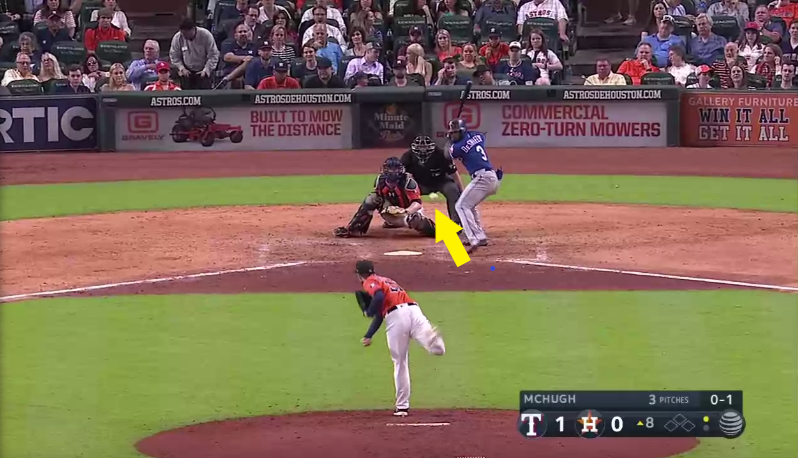
This screengrab is very purposeful, as this is the exact moment that DeShields’ hands start moving forward. This means that DeShields not only has made his decision to swing, but he also is starting the process of swinging. At this point, this pitch looks very much like a fastball headed for the inside of the corner of the plate. This is the whole idea behind pitch tunneling, after all — it looks like a certain pitch, until it doesn’t. DeShields pulls the trigger and then this happens:
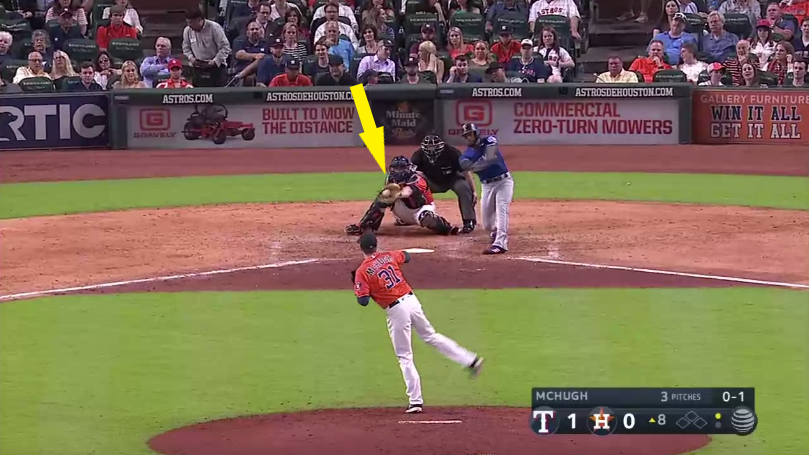
It is decidedly not an inside fastball. McHugh pulls the string, DeShields is sent flailing at air, and the ball ends up outside, off of the plate. There’s nothing you can do with this pitch. You could take it, I guess, but good luck taking a pitch that starts on one side of the plate and ends up on the other.
Since it has become such an effective pitch, you would expect him to use it more often. It’s all the rage nowadays, after all.
McHugh’s pitch usage, over the years:
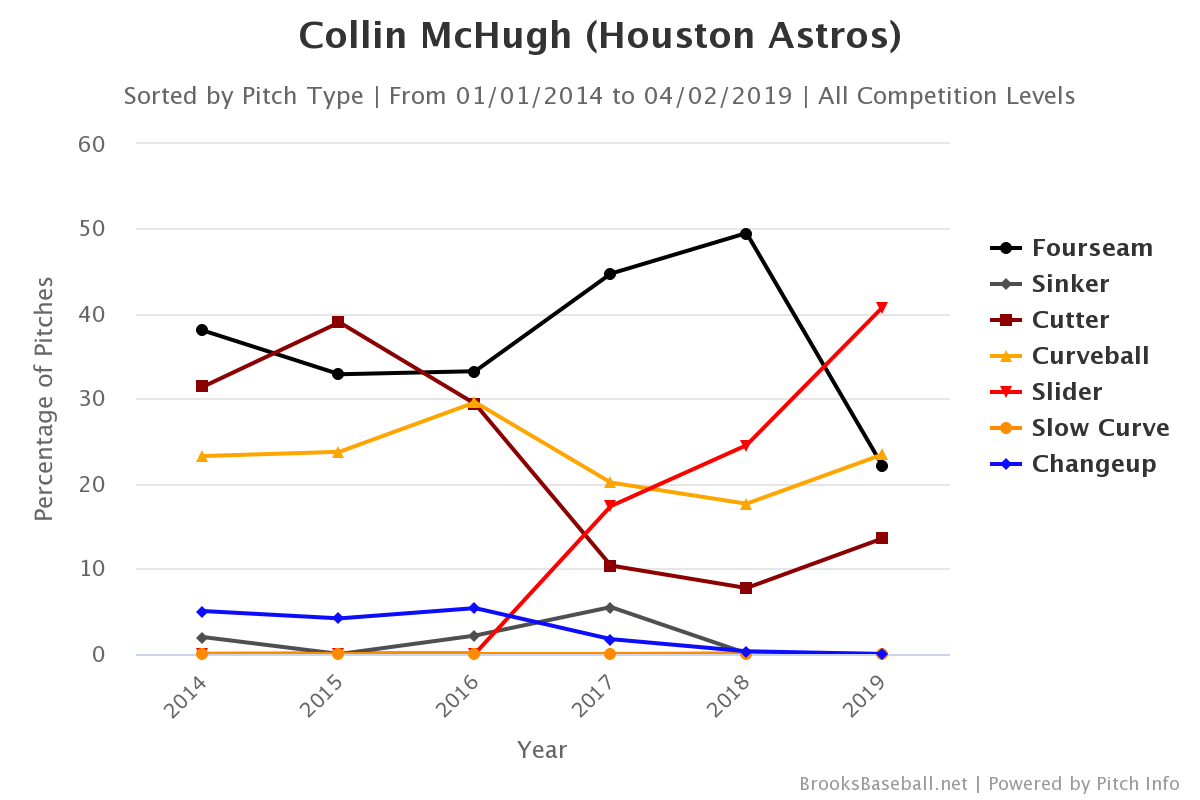
For me, there are two things to highlight. By now, most of us know that McHugh has a lights-out curveball. He doesn’t pitch it in the zone enough to be a Money Pitch, but it’s great. For McHugh to have enough confidence in his slider to use it more than his curveball — that’s impressive enough. But now, McHugh has ditched his fastball — he’s used it about as much as his curveball this year — and he’s thrown his slider 40% of the time this year. For those keeping track at home, that’s 64.2% breaking stuff and 35.8% hard pitches. You might expect this sort of stuff from a reliever, but McHugh lives in the rotation now. I repeat: This is bananas!
Now, McHugh has talked about how his slider was a weapon against righties — and it is! McHugh’s meh 2017 slider netted him a 0.277 xwOBA against righties, while his new slider xwOBA in 2018 was 0.132 against righties. None of his other pitches improved from 2017 to 2018 by xwOBA and so his slider deserves the bulk of the credit for his improvement — if not all of it. But if you don’t look closely enough, you might miss something, especially because even McHugh doesn’t speak highly of his slider as an out-pitch against lefties. (Hint: I just spoiled it.)
McHugh versus righties:
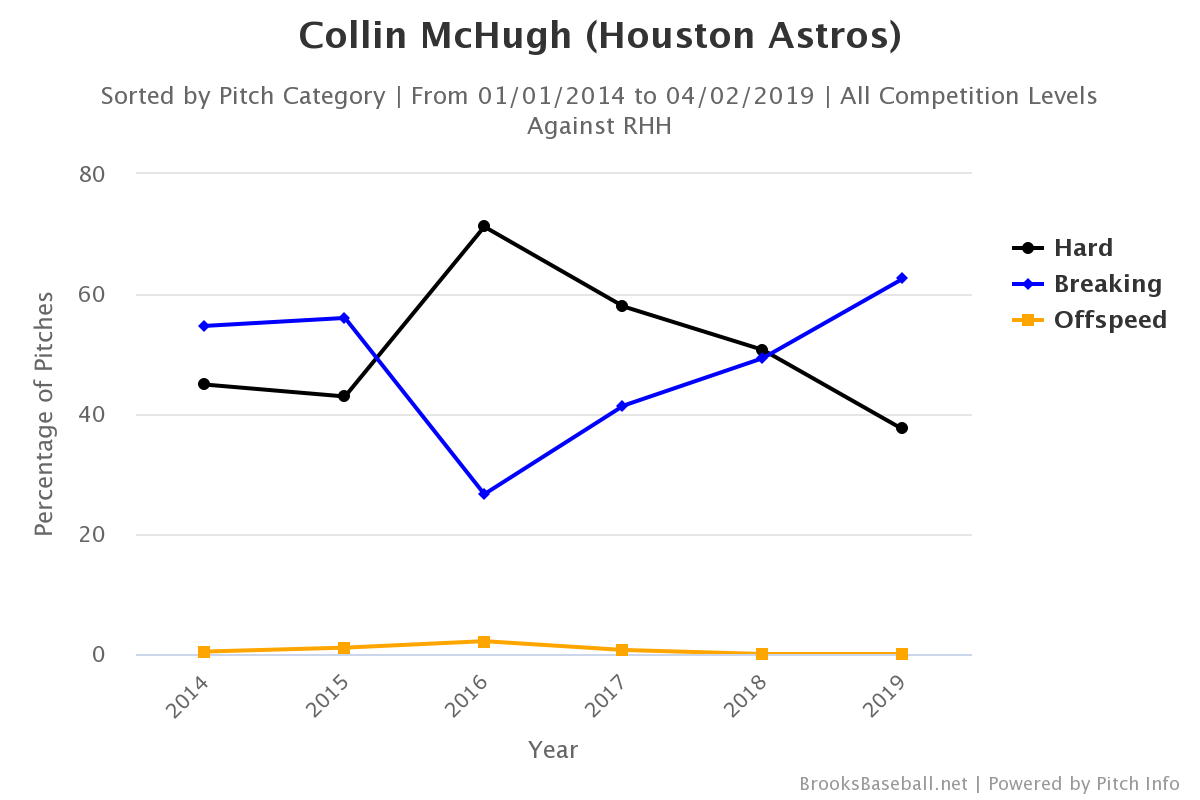
Interesting enough. You can’t see it here, but that’s 50% sliders and 12% curveballs. Last year was equal parts hard and breaking stuff. Cool stuff!
McHugh versus lefties:
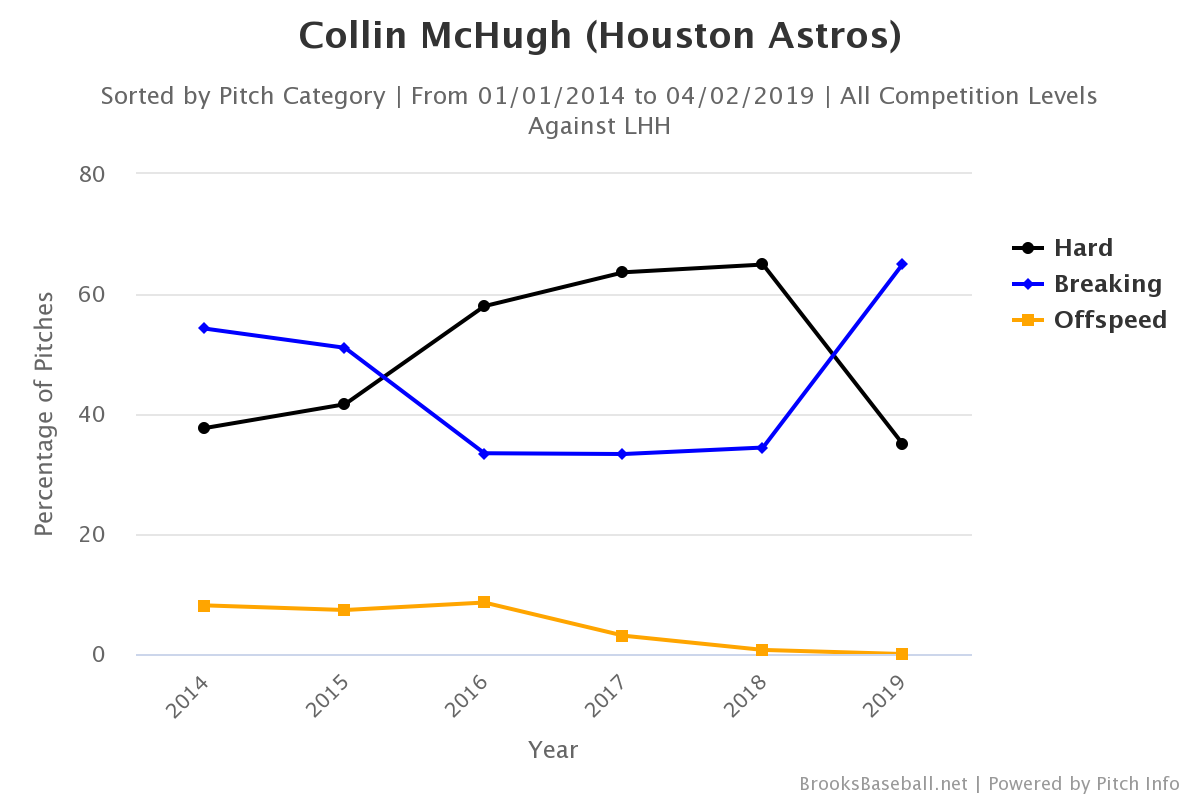
Now this is where McHugh has gotten crazy this year. Against lefties, he went from 5% sliders in 2017 to 9% in 2018 and now 36% in 2019. McHugh is evolving. This is a massive shift in pitch usage and it shows that, at least thus far, McHugh has a lot of confidence in his slider against lefties. At least, enough to throw his slider 36% of the time, compared to 28% for his curveball. His sliders are up overall this year because he’s throwing them more to righties, but the reason they’re this inflated is he is able to feature sliders as a primary pitch against lefties.
Here’s an at-bat from Brandon Lowe in which he never really stood a chance against McHugh.
First pitch, slider on the black for a called strike.
Curveball! Lowe just makes contact.
Slider, popped up out of play.
Wicked curveball at Lowe’s back foot. No chance.
It took just four pitches for McHugh to dispatch a left-handed hitter. Most importantly, McHugh never had to turn to his hard stuff. Now I admit, this at-bat could have gone differently. Maybe McHugh doesn’t get the called strike on his first slider. That could have changed his whole approach. But he did get the strike! The point, then, is that going forward, maybe that doesn’t dissuade McHugh from continuing to throw his breaking balls when he’s behind in the count — whether it’s his slider or his curveball.
It’s early — too early, you could certainly argue — but McHugh his improved slightly against righties and, more importantly, he’s improved drastically against lefties. He would be hard-pressed to maintain his 0.325 to 0.216 improvement in xwOBA against lefties, but the point is that he’s made changes and he’s seen the improvements as a result.
McHugh has already shown he can consistently be something like a 3 WAR starting pitcher. Then, he showed us he can be an asset as a versatile reliever who can be effective for two to three innings per outing. That was before he started flashing the slider more than his fastball, never mind the fact that he already had his curveball. McHugh said it himself: He needed another pitch to differentiate from his bender. He found it and now he’s the best he’s ever been. If we are to revisit the SIERA piece from the beginning of this article, which surely is mostly to be used as a shortcut, then maybe McHugh is more of a low-3s ERA pitcher than the low-4s ERA pitcher he was. He isn’t the only pitcher doing this with his slider, but then again, most others are doing it out of necessity. McHugh has had the fastball that the others don’t and he had the curveball too. Now he’s weaponized a third offering in his slider and, as far as I’m concerned, the only thing that could hold him back is his health. It’s April, for heaven’s sake, but Collin McHugh has taken it upon himself to be a sports fan and writer’s dream alike.
(Photo by Keith Gillett/Icon Sportswire)
(All GIFs courtesy of Dave Cherman and Michael Ajeto)


I’m really glad that Nick convinced me to draft him in the 21st round.